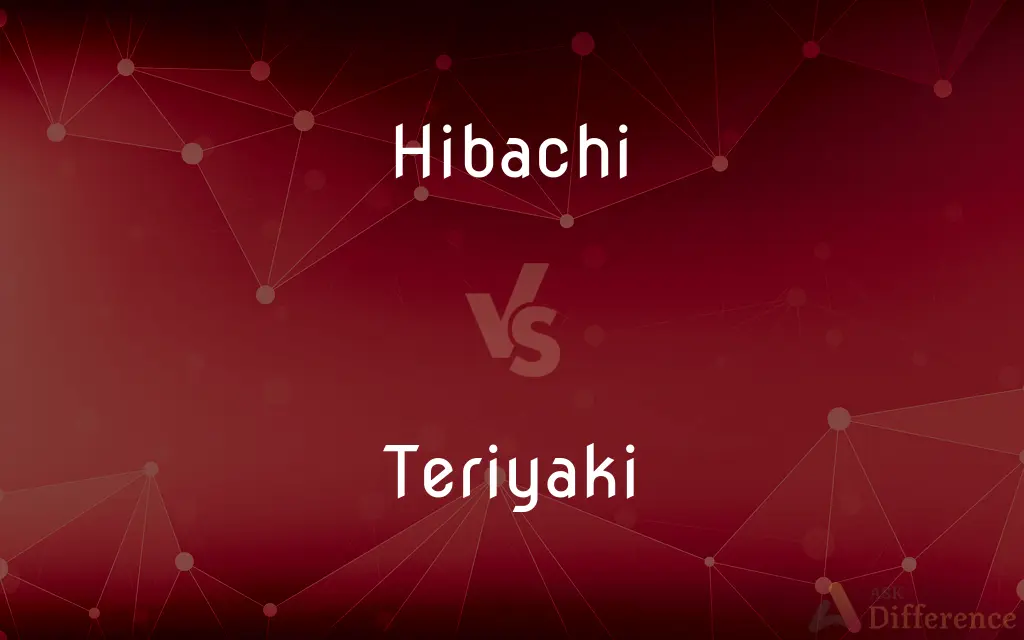Hibachi vs. Teriyaki — What's the Difference?
By Maham Liaqat & Fiza Rafique — Updated on April 1, 2024
Hibachi is a Japanese cooking style using a high-heat open grate grill, focusing on grilled dishes, while teriyaki refers to a sweet and savory sauce used in Japanese cuisine to marinate or glaze cooked foods.

Difference Between Hibachi and Teriyaki
Table of Contents
ADVERTISEMENT
Key Differences
Hibachi involves cooking food on a metal plate or grill at high temperatures, which allows for quick searing and cooking of meats, vegetables, and seafood. This method emphasizes direct grilling and is often performed in front of guests as a form of entertainment. Teriyaki, on the other hand, is a cooking technique and flavoring style where foods are marinated or glazed with a teriyaki sauce made from soy sauce, sake or mirin, and sugar, creating a glossy, flavorful finish.
The primary focus in hibachi cooking is on the technique and the interaction between the chef and the diners, offering a visual and interactive dining experience. Teriyaki focuses more on the taste and texture of the food, with the sauce providing a distinctively sweet, tangy, and slightly salty flavor profile.
Hibachi chefs typically use minimal seasoning, relying on the high heat of the grill to enhance the natural flavors of the food. In contrast, teriyaki dishes are characterized by their rich sauce, which adds depth and complexity to the flavor of the dishes it accompanies.
Restaurants specializing in hibachi cooking often feature communal seating around large grills, where chefs perform cooking demonstrations, including tricks and food tossing. Teriyaki can be found in various settings, from casual dining and street food to fine dining, where the sauce is used to complement sushi, grilled items, and other dishes.
The versatility of hibachi means it can be used to cook a wide range of foods without the need for additional flavoring agents beyond light seasonings. Teriyaki sauce, however, is versatile in a different way, serving as a marinade or glaze for various meats, vegetables, and sometimes even used as a dipping sauce.
ADVERTISEMENT
Comparison Chart
Definition
A Japanese cooking style using a grill.
A cooking technique and sauce in Japanese cuisine.
Cooking Method
Direct grilling on an open grate or plate.
Marinating or glazing with teriyaki sauce.
Focus
Technique and diner interaction.
Flavor and texture of the food.
Flavoring
Minimal, emphasizes natural flavors.
Sweet, tangy, and slightly salty sauce.
Dining Experience
Interactive with live cooking shows.
Versatile, used in various dining settings.
Versatility
Cooks a wide range of foods.
Used as a marinade, glaze, or dipping sauce.
Compare with Definitions
Hibachi
A style of Japanese cooking on a high-heat metal cooking plate.
We enjoyed a hibachi dinner where the chef prepared our meal right in front of us.
Teriyaki
Adds a sweet and savory taste to dishes.
Teriyaki salmon offers a perfect balance of sweetness and umami.
Hibachi
Emphasizes quick grilling of meats and vegetables.
Hibachi grilling brings out the natural flavors of the ingredients.
Teriyaki
Characterized by its glossy finish and flavor.
The teriyaki sauce added a beautiful shine and depth of flavor to the dish.
Hibachi
Features communal dining around the grill.
The communal hibachi table fostered a shared dining experience.
Teriyaki
A cooking style using a glaze of soy sauce, mirin, and sugar.
The chicken was marinated in teriyaki sauce before grilling.
Hibachi
Known for its entertaining cooking demonstrations.
The hibachi chef amazed us with his skillful knife tricks.
Teriyaki
Versatile in application, from marinades to dips.
Apart from glazing, the teriyaki sauce was also served as a dip.
Hibachi
Often involves minimal seasoning.
Hibachi dishes rely on the quality of the ingredients and the chef's technique.
Teriyaki
Common in both traditional and modern Japanese cuisine.
Teriyaki burgers are a popular fusion dish combining Japanese flavors with American fast food.
Hibachi
The hibachi (Japanese: 火鉢, "fire bowl") is a traditional Japanese heating device. It consists of a round, cylindrical, or box-shaped, open-topped container, made from or lined with a heatproof material and designed to hold burning charcoal.
Teriyaki
Teriyaki (kanji: 照り焼き) is a cooking technique used in Japanese cuisine in which foods are broiled or grilled with a glaze of soy sauce, mirin, and sugar.Fish – yellowtail, marlin, skipjack tuna, salmon, trout, and mackerel – is mainly used in Japan, while white and red meat – chicken, pork, lamb, and beef – is more often used in the West. Other ingredients sometimes used in Japan include squid, hamburger steak, and meatballs.
Hibachi
A portable cooking apparatus similar to a small barbecue.
Teriyaki
A Japanese dish of grilled or broiled slices of meat or seafood that have been marinated in a mixture of soy sauce, sugar or honey, garlic, ginger, and mirin.
Hibachi
A portable charcoal-burning brazier with a grill, used chiefly for cooking.
Teriyaki
The sauce used to marinate such a dish.
Hibachi
A portable brazier, powered by charcoal, used for cooking.
Teriyaki
A cooking technique used in Japanese cuisine in which foods are broiled or grilled in a sweet soy sauce marinade.
Hibachi
(North America) A cooking method and performance art in which the chef grills pieces of food on a hot metal griddle in front of the guests; teppanyaki. This terminology is virtually unknown in Japan.
Teriyaki
A sweet soy sauce marinade.
Put some teriyaki on it.
Hibachi
(North America) The griddle used in such cuisine; teppan.
Teriyaki
Beef or chicken or seafood marinated in spicy soy sauce and grilled or broiled
Hibachi
A portable brazier that burns charcoal and has a grill for cooking
Hibachi
Cook over a hibachi grill
Common Curiosities
What defines teriyaki in Japanese cuisine?
Teriyaki refers to both a cooking method and the sauce used in this method, characterized by a glaze of soy sauce, mirin, and sugar.
How do hibachi and teriyaki differ in flavor?
Hibachi focuses on enhancing the natural flavors of the food through grilling, while teriyaki introduces a sweet, tangy, and savory flavor profile with its sauce.
Is teriyaki considered healthy?
Teriyaki sauce can be high in sugar and sodium, but its healthiness depends on the overall balance of the diet and the portion size used.
Can I make teriyaki sauce at home?
Yes, teriyaki sauce can be easily made at home with soy sauce, mirin (or a sweet wine), and sugar, adjusted to taste.
What is typically served at a hibachi restaurant?
Hibachi restaurants often serve grilled meats, seafood, and vegetables, accompanied by rice and noodles, with chefs performing cooking shows.
Do hibachi chefs use teriyaki sauce?
Some hibachi chefs may use teriyaki sauce to flavor dishes, although the primary focus remains on the grilling technique.
What is hibachi cooking?
Hibachi is a Japanese cooking style where food is cooked on a high-heat metal grilling surface, often with minimal seasoning.
Can teriyaki sauce be used in hibachi cooking?
Yes, teriyaki sauce can be used to marinate or glaze foods cooked on a hibachi grill, combining both styles for flavorful dishes.
What makes hibachi an interactive dining experience?
The live cooking performances and the chef's interaction with diners at the grill make hibachi dining uniquely interactive.
What dishes are best with teriyaki sauce?
Teriyaki sauce pairs well with grilled chicken, beef, fish, and vegetables, offering a versatile flavor enhancer.
How do I know if a dish is cooked hibachi style or with teriyaki?
If the dish is grilled with minimal seasoning and served straight from the grill, it's likely hibachi. If it has a sweet and glossy sauce, it's prepared with teriyaki.
Is hibachi cooking done only on special grills?
Traditional hibachi cooking is done on specific grills, but similar techniques can be adapted for home use on various griddles or grills.
What's the origin of teriyaki sauce?
Teriyaki sauce originates from Japan, with "teri" meaning luster (referring to the sauce's shine) and "yaki" indicating the cooking method (grilling or broiling).
Is hibachi suitable for vegetarians?
Yes, hibachi can accommodate vegetarians by grilling a variety of vegetables and tofu instead of meat.
How do I choose between hibachi and teriyaki?
The choice depends on personal preference for cooking style and flavor; hibachi for grilling and interaction, teriyaki for sweet and savory dishes.
Share Your Discovery

Previous Comparison
Vibes vs. Vibe
Next Comparison
Bake vs. BoilAuthor Spotlight
Written by
Maham LiaqatCo-written by
Fiza RafiqueFiza Rafique is a skilled content writer at AskDifference.com, where she meticulously refines and enhances written pieces. Drawing from her vast editorial expertise, Fiza ensures clarity, accuracy, and precision in every article. Passionate about language, she continually seeks to elevate the quality of content for readers worldwide.














































